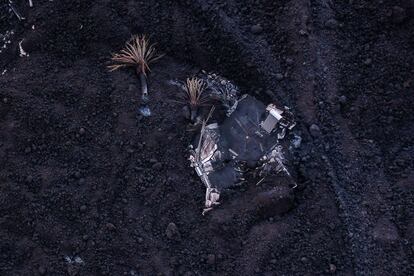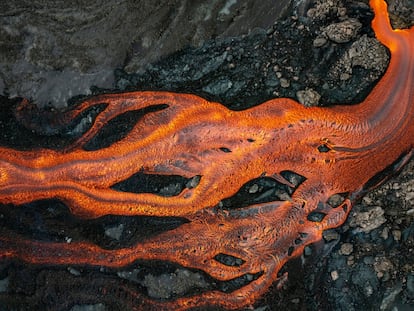La Palma volcano comes to stop: ‘It is not emitting lava, nor sulfur dioxide, nor registering seismic activity’
Scientists consider it ‘improbable’ that it will reactivate, but are not ruling out that possibility for now
The activity of the volcano on the Canary Island of La Palma stopped completely on Tuesday, nearly three months after it first began to erupt. “It is not emitting lava, nor sulfur dioxide, nor is it registering any tremors or seismic activity,” sources from the National Geographic Institute (IGN) confirmed. The same sources consider it “improbable” that it will restart its activity, but are not ruling that possibility out for now.
For this reason, sources from the team of experts monitoring the phenomenon, the Volcano Risk Prevention Plan (Pevolca), are opting to wait several days before certifying its definitive demise. Miguel Ángel Morcuende, the technical director of Pevolca, had already announced during a press conference on Tuesday that the volcanic activity had fallen to the point that it had “practically disappeared,” albeit describing the situation as an “impasse.” Is this the end? The scientists are being prudent before speaking about any conclusion to the eruption.
Last Sunday saw the new volcano on the island register an uptick in activity in terms of the emission of lava and gases. On Monday, all of the measures fell drastically. The spokesperson for the scientific committee at Pevolca, María José Blanco, pointed out at the time that the 2011 eruption of the underwater volcano of Canary Island El Hierro also saw intense pulses of energy shortly before activity came to an end. Today, Wednesday, the experts from Pevolca will decide how long this period of inactivity will have to continue before the eruption can be considered to have ended on La Palma, which is part of the Spanish archipelago located off the northwest of Africa.
The technical director explained on Tuesday that given the signs from the volcano, the scientific committee had concluded that activity had “clearly diminished.” Using data from the morning, he explained that these signs included the tremor – a sustained seismic signal caused by the rise of magma and gases to the surface – which was “practically nonexistent,” and was at levels that barely qualified as background noise. What’s more, seismic activity remained at very deep levels, at intermediate depths and below the 20-kilometer mark. At the same time, there were no signs of uplift at the surface given the lack of pressure coming from underground.

Lava flows from the new volcano have so far destroyed 1,646 buildings – 1,318 of which were homes – as well as 73 kilometers of roads and 369 hectares of crops. The advance of the molten rock, which has covered 1,221 hectares of land, forced the evacuation of more than 7,000 people. Among these, some 2,300 residents of La Palma have lost their homes.
Morcuende explained on Tuesday that the lava flows were continuing to emanate from the western base of the cone, above all via lava tubes – natural conduits formed by flowing lava from a volcanic vent – albeit with a “highly weakened” output. Meanwhile, the delta created in the sea in Las Hoyas, in Tazacorte municipality in the west of the island, did not extend any further into the water on Tuesday, with the lava moving over previous flows.
In spite of all of the observable falls in activity from the volcano, the Pevolca technical director stated that there was a need to “continue waiting” before concluding that the eruption had come to an end. “There could be one impression while the reality is different,” he stated on Tuesday. He added that the attitude of the scientific committee had been “clearly one of prudence, of calm and of waiting,” given that “in principle, this is going reasonably well, but no more than that.”
Morcuende also pointed out that the calm situation on Tuesday had been similar to that of the day before, and that on Monday there had been an unexpected burst of energy, “with a significant emission of lava that caused concern, in particular given how wide it was,” explaining that it measured nearly 200 meters across at points.
The new – and still unnamed – volcano on La Palma began to erupt on September 19. Its 86 days of life have made it the longest eruption in the history of the Canary Island, after exceeding the length of activity of Tehuya in 1585. In terms of the entire archipelago, it is on a par with Tao (or del Clérigo) eruption on Lanzarote, which lasted 86 days in 1824. It is still, however, short of the eruption of Narices del Teide, in Tenerife (99 days in 1798), and the six years that the eruption of Timanfaya lasted in Lanzarote in 1730.
Tu suscripción se está usando en otro dispositivo
¿Quieres añadir otro usuario a tu suscripción?
Si continúas leyendo en este dispositivo, no se podrá leer en el otro.
FlechaTu suscripción se está usando en otro dispositivo y solo puedes acceder a EL PAÍS desde un dispositivo a la vez.
Si quieres compartir tu cuenta, cambia tu suscripción a la modalidad Premium, así podrás añadir otro usuario. Cada uno accederá con su propia cuenta de email, lo que os permitirá personalizar vuestra experiencia en EL PAÍS.
¿Tienes una suscripción de empresa? Accede aquí para contratar más cuentas.
En el caso de no saber quién está usando tu cuenta, te recomendamos cambiar tu contraseña aquí.
Si decides continuar compartiendo tu cuenta, este mensaje se mostrará en tu dispositivo y en el de la otra persona que está usando tu cuenta de forma indefinida, afectando a tu experiencia de lectura. Puedes consultar aquí los términos y condiciones de la suscripción digital.
More information
Últimas noticias
There is as much life left to discover on planet Earth as that which is already known
Dozens presumed dead, around 100 injured in fire at Swiss Alps bar during New Year’s celebration
Is porn for women different from conventional porn? We spoke to those who make it
Cartagena de Indias is sinking: What can the city do to mitigate it?
Most viewed
- Reinhard Genzel, Nobel laureate in physics: ‘One-minute videos will never give you the truth’
- Sinaloa Cartel war is taking its toll on Los Chapitos
- David King, chemist: ‘There are scientists studying how to cool the planet; nobody should stop these experiments from happening’
- Oona Chaplin: ‘I told James Cameron that I was living in a treehouse and starting a permaculture project with a friend’
- The Interoceanic Train, the Mexican alternative to the Panama Canal












































